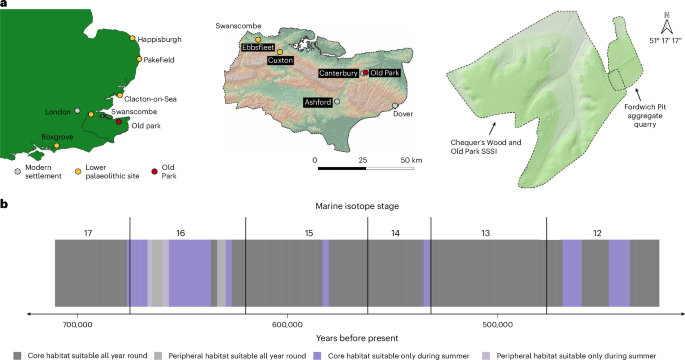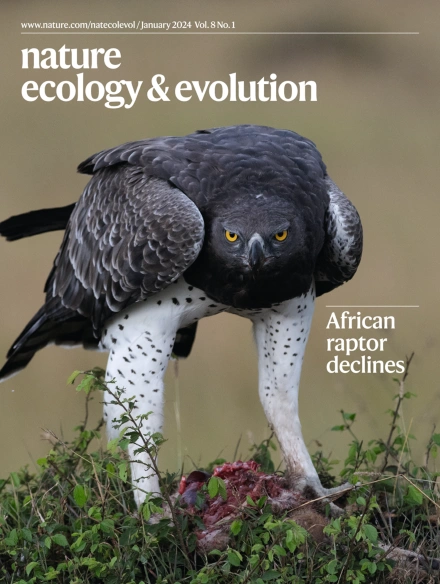Hominin glacial-stage occupation 712,000 to 424,000 years ago at Fordwich Pit, Old Park (Canterbury, UK)
IF 13.9
1区 生物学
Q1 ECOLOGY
引用次数: 0
Abstract
Few high-latitude archaeological contexts are older than marine isotope stage (MIS) 15 and even fewer provide evidence of early human occupation during a glacial period. New discoveries at Old Park, Canterbury (UK), provide evidence of both the oldest accessible artefact-bearing sediment in northern Europe and cold-stage adaptation. Radiometric and palaeomagnetic dating places the earliest suggested occupation of this site between 773 thousand years ago (ka) and 607 ka, with hominin presence inferred during MIS 17–16. Two additional artefact-bearing stratigraphic units, dated to around 542 ka and 437 ka, strongly align with the MIS 14 and 12 cold stages, respectively. The latter unit contains convincing evidence of glacial-stage occupation by Acheulean hominins; fresh, unabraded flakes (including biface-thinning) between clearly defined glacial-aged sediments displaying mixed grassland palaeoenvironmental evidence. An historically collected assemblage of more than 330 handaxes is argued to be derived from both the MIS 17–16 and MIS 12 sediments, providing evidence of the earliest known Acheulean bifaces in northern Europe, and re-occupation by Acheulean populations 200,000 years later. Together, Old Park provides evidence for Lower Palaeolithic hominins reoccupying a location over several mid-Pleistocene MIS cycles, early human presence above 51° latitude during a glacial stage and handaxe production in northern Europe from MIS 17 to 16. The authors report Acheulean hominin occupation of eastern Britain during glacial marine isotope stages 17–16 and again in glacial marine isotope stage 12 via stone tools in sediments dated to 712,000 to 424,000 years ago.


71.2万至42.4万年前人类在老公园(英国坎特伯雷)的福德维奇坑的冰期活动
很少有高纬度考古背景比海洋同位素阶段(MIS) 15更古老,更少的证据表明早期人类在冰期居住。在坎特伯雷旧公园(英国)的新发现,提供了北欧最古老的人工制品沉积物和寒冷阶段适应的证据。辐射测年和古地磁测年表明,该遗址最早存在于77.3万年前至607年之间,在MIS 17-16期间推断出人类的存在。另外两个含人工制品的地层单元,其年代约为542 ka和437 ka,分别与MIS 14和12冷期密切相关。后者包含了阿舍利古人类在冰川期占据的令人信服的证据;在明确界定的冰河时代沉积物之间的新鲜的、未磨损的薄片(包括双面变薄),显示混合的草地古环境证据。历史上收集到的330多个手斧组合被认为来自MIS 17-16和MIS 12沉积物,提供了已知最早的阿舍利双面面在北欧的证据,以及20万年后阿舍利人重新占领的证据。总之,Old Park提供了证据,证明在几个中更新世MIS周期中,较低的旧石器时代人类重新占据了一个位置,在冰河时期,早期人类出现在51°纬度以上,并在MIS 17至16期间在北欧生产手斧。
本文章由计算机程序翻译,如有差异,请以英文原文为准。
求助全文
约1分钟内获得全文
求助全文
来源期刊

Nature ecology & evolution
Agricultural and Biological Sciences-Ecology, Evolution, Behavior and Systematics
CiteScore
22.20
自引率
2.40%
发文量
282
期刊介绍:
Nature Ecology & Evolution is interested in the full spectrum of ecological and evolutionary biology, encompassing approaches at the molecular, organismal, population, community and ecosystem levels, as well as relevant parts of the social sciences. Nature Ecology & Evolution provides a place where all researchers and policymakers interested in all aspects of life's diversity can come together to learn about the most accomplished and significant advances in the field and to discuss topical issues. An online-only monthly journal, our broad scope ensures that the research published reaches the widest possible audience of scientists.
 求助内容:
求助内容: 应助结果提醒方式:
应助结果提醒方式:


